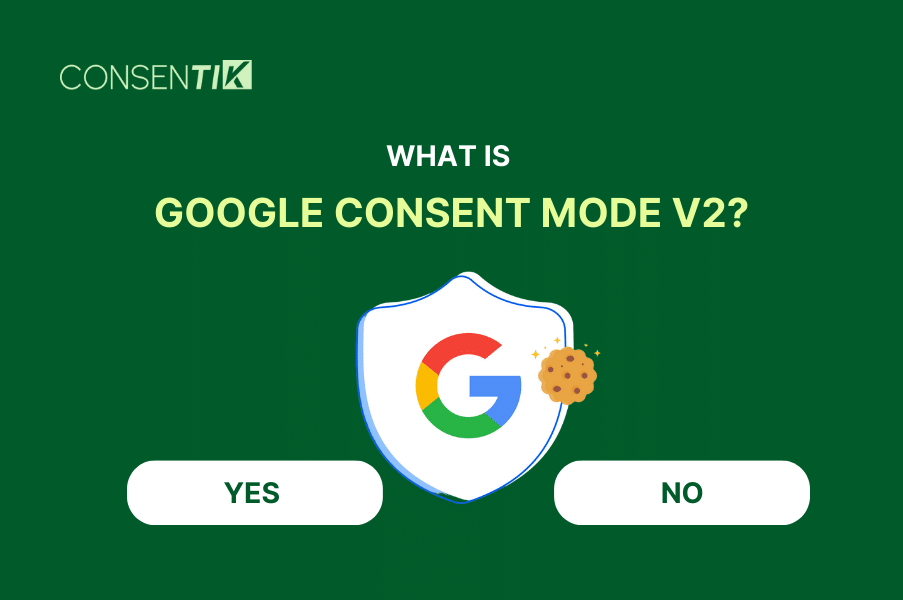Navigating the complexities of data privacy has become increasingly crucial for businesses, especially with the introduction of Google Consent Mode v2. This update, essential for compliance with evolving privacy regulations, is a game-changer for how websites manage user consent. By March 2024, implementing Consent Mode v2 will be mandatory, and understanding its intricacies is key to staying compliant while maintaining robust data analytics.
What is Google Consent Mode V2?
Google Consent Mode V2 is a feature that works with your website’s consent management platform (CMP). It changes how Google tags work based on whether a user gives consent or not. This means you can still collect useful data without breaking privacy rules. Consent Mode V2 helps you get accurate data and ensures that tags for analytics and marketing only run when users allow them.
For example, if a user doesn’t consent to tracking, Google Consent Mode V2 ensures that no personal data is collected, but it still allows for aggregated data collection. This means you can still understand user behavior and optimize your website without violating privacy laws. By using Consent Mode V2, you maintain the balance between gaining valuable insights and respecting user privacy.
What Does Google Consent Mode V2 do?

Privacy laws like GDPR in Europe and CCPA in California are becoming stricter, and businesses need to keep up. Google Consent Mode V2 is a helpful tool that makes it easier to follow these rules and protect user data. Here’s why this tool is so important for businesses:
Help You Follow Privacy Laws
Google Consent Mode V2 helps your website comply with privacy laws by changing how data is collected based on what users agree to. For example, if a user doesn’t want their data tracked, the tool ensures no personal data is collected. This helps you avoid fines and legal problems, keeping your business safe.
Allow You to Still Get Useful Data
Even if users choose not to be tracked, Consent Mode V2 allows you to collect important data that doesn’t identify anyone personally. This type of data shows how your website is performing, such as how many people visit and what pages they look at. You can use this information to make your website better without invading anyone’s privacy.
Build Trust with Your Users
When people see that you respect their privacy choices, they feel more comfortable and trust your website. This trust can lead to better relationships with your customers, more repeat visits, and higher chances of them buying from you. Simply put, respecting privacy makes people more likely to do business with you.
Make a Better Experience for Everyone
These benefits show that Google Consent Mode V2 isn’t just about following the rules; it’s about making your website a better place for users. By using this tool, you demonstrate that you value your customers’ privacy, which can help set you apart from competitors and build a loyal customer base.
Types of Consent in Google Consent Mode V2
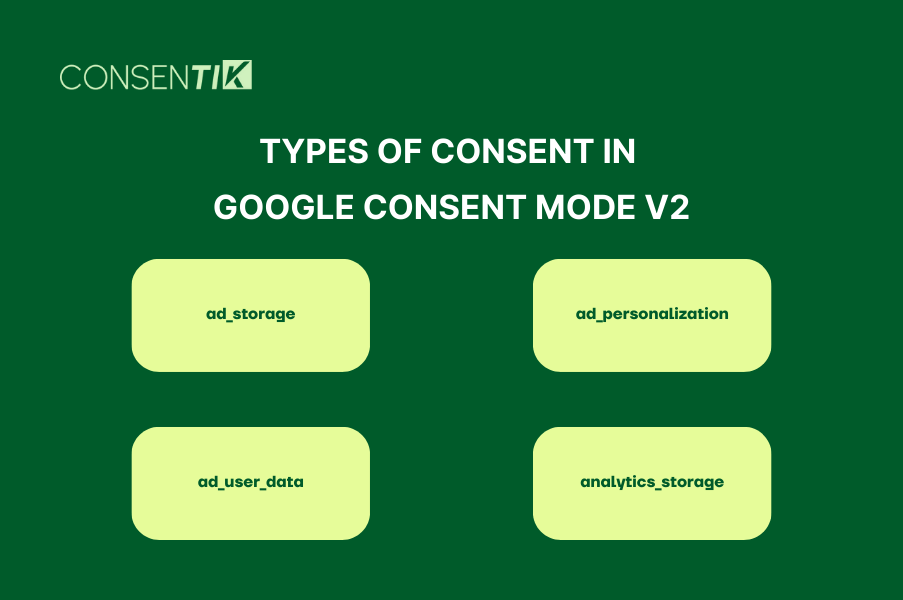
With the release of Google Consent Mode 2024, there are new ways to manage user consent for digital ads and analytics. This update is now the standard for businesses using Google Advertising Services, making it very important to understand the types of consent available. Let’s go over the 4 types of consent in Consent Mode V2 and the 2 modes it offers.
The 4 Types of Consent in Consent Mode V2
| Type | Description | Application |
|---|---|---|
| ad_storage | Collects data about user activity to show relevant ads. | Helps show ads that match user interests, improving ad performance. |
| ad_user_data | Gathers data linked to specific users based on their behavior. | Displays ads targeted to a user’s browsing habits and preferences. |
| ad_personalization | Customizes ads using user data to make them more specific. | Tailors ads to individual users, increasing relevance and clicks. |
| analytics_storage | Collects data on how users interact with a website. | Improves user experience and helps businesses make data-driven decisions. |
Google Consent Mode V2 also introduces 2 modes that determine how data is used based on user consent. Knowing these modes helps ensure your website follows privacy rules while also making the most of available data.
Basic Consent Mode
In Basic Consent Mode, Google tags do not collect data for personalized ads or analytics if the user does not give consent. This means that all ads will be general and not targeted. This mode is important for businesses in areas with strict privacy laws or for users who prefer not to share personal data. By respecting user choices, you build trust and avoid legal issues.
Advanced Consent Mode
Advanced Consent Mode allows Google tags to use anonymized data even if the user does not give full consent. This data is not linked to individual users but can still help in creating more relevant ads and gathering useful analytics. For businesses, this mode provides a good balance between using some data for personalization and respecting user privacy.
With the Consentik app integrating Advanced Consent Mode, businesses can make the most of anonymized data to improve ad performance and gain useful insights, all while keeping user trust and privacy intact.
> Our advice: Choosing between Basic and Advanced Consent Modes depends on your business needs and your audience’s privacy preferences. If you operate in a market with strict privacy rules, Basic Consent Mode might be best. If you want to personalize ads while respecting privacy, Advanced Consent Mode can be a better choice.
The key is to be clear with users about how their data will be used and to give them simple options for consent. This helps build trust and ensures compliance while still allowing you to optimize your marketing strategies.
How Does Google Consent Mode V2 Work?
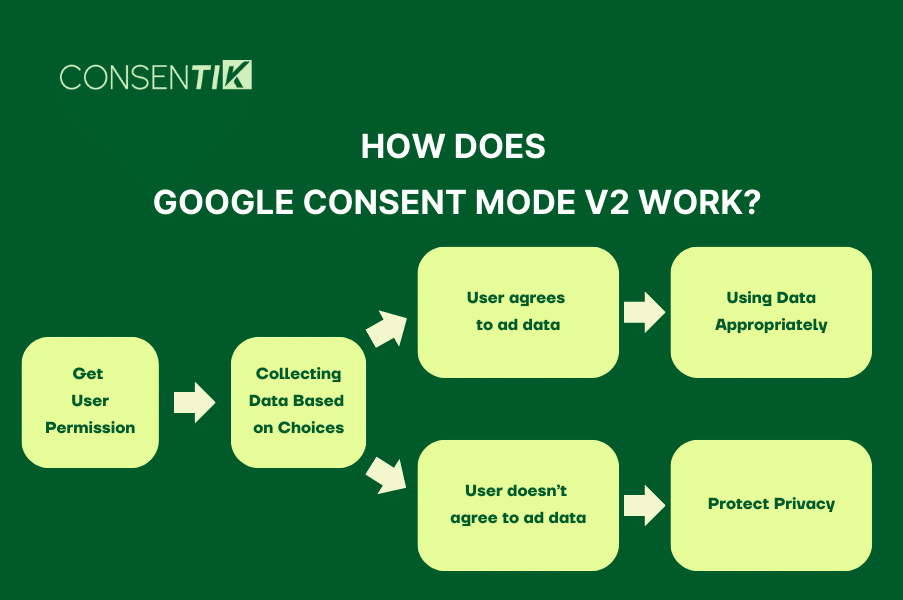
As you know, Google Consent Mode V2 helps websites manage user privacy by controlling what data is collected based on user choices. Here’s how it works in simple terms:
- Getting User Permission: When someone visits a website, they see a pop-up asking if they agree to share their data for things like ads or website analytics. The user can choose what they’re okay with.
- Collecting Data Based on Choices: Depending on what the user agrees to, Google Consent Mode V2 changes how data is collected:
- If the user agrees to ad data, the website can collect information like what they click on to show more relevant ads.
- If the user does not agree to ad data, the website will not collect personal information for ads.
- Using Data Appropriately: Once the user has given their consent, the tool allows the website to send data to Google in a way that matches the user’s choices. This data can help improve ads or understand how users interact with the site.
- Protecting Privacy: If a user says no to certain data collection, Google Consent Mode V2 makes sure that no data is collected in those areas. This helps websites follow privacy laws and shows respect for user privacy.
So basically, Google Consent Mode V2 ensures that websites only collect and use data in ways that the user has agreed to, keeping their privacy safe.
How to Implement Google Consent Mode V2?
Google Consent Mode V2 implementation on your website is easier than you might think. This simple guide will help you get started while ensuring you protect user privacy and comply with data protection laws.
Manual Implementation
Manually implementing Google Consent Mode is possible but not recommended because it’s complicated and can easily lead to mistakes. It requires directly changing your website’s code to make sure each Google tag (like Google Analytics or Google Ads) works according to the user’s consent. This process can be time-consuming and difficult, especially if you’re not comfortable with coding.
Steps involved:
- List all Google tags: Identify all the Google tags on your site, such as Google Analytics, Google Ads, or Google Tag Manager. You need to know which tags will be affected by consent.
- Define consent options: Set up rules for the different consent states: “granted,” “denied,” or “unknown.” These rules determine how tags should behave based on the user’s choice.
- Write the code: This code is to check whether the user has consented. If they haven’t, the tags should not collect data. If they have, the tags should work normally.
- Test thoroughly: Ensure that the tags work correctly in every scenario. For example, check that no data is collected if the user denies consent and that the tags activate when consent is given.
Manual implementation gives you full control, but it’s tricky and error-prone, so it’s generally better to use an easier solution like Google Tag Manager.
Google Tag Manager (GTM) Implementation
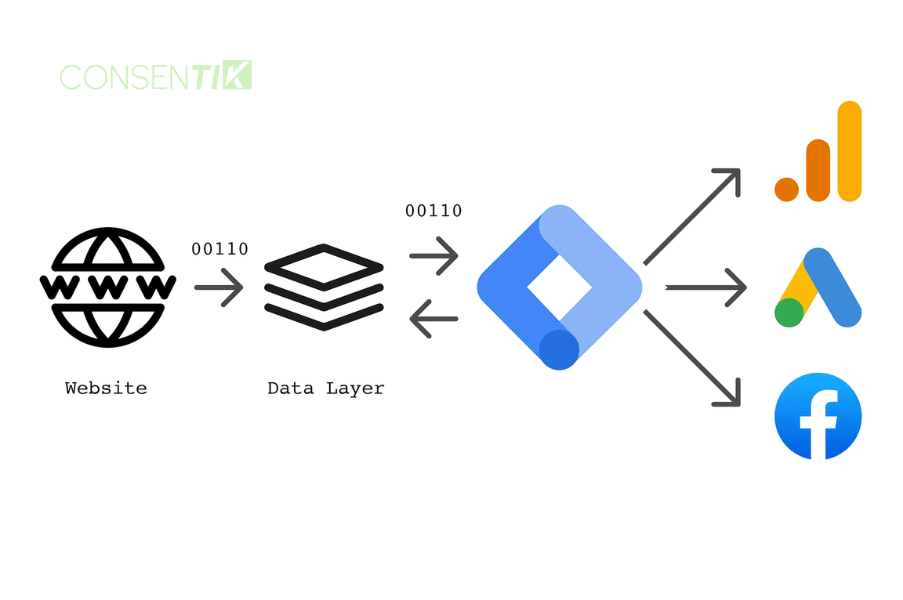
Using Google Tag Manager (GTM) makes it much easier to set up Google Consent Mode. GTM gives you a simple interface to manage all your tags in one place, so you don’t have to change your website’s code manually. This makes the process faster, more reliable, and much easier to maintain.
Steps involved:
- Create consent variables: In GTM, create variables (like consent_granted) to track whether the user has given consent for things like analytics or advertising.
- Add Consent Mode settings to tags: In GTM, update your Google tags (like Google Analytics or Ads) with Consent Mode parameters. This ensures that the tags will adjust automatically based on the user’s consent. For example, if consent is denied, the tag won’t collect data, but it might still send a cookieless ping.
- Set triggers for when tags should fire: Use triggers in GTM to control when tags are activated based on the user’s consent. For example, a trigger can be set to make sure an ad tag only fires if consent is granted.
GTM simplifies the whole process, reducing the chance of errors and making it easier to manage consent and tags without needing to code.
Using Consentik for Shopify Website

The Consentik app helps Shopify merchants easily implement Google’s Consent Mode. This allows websites to respect user consent for cookies while still collecting important data for analytics and ads. It ensures compliance with privacy laws and keeps e-commerce platforms running efficiently by managing data collection based on user preferences. This way, you can track key metrics without violating regulations.
Setting up Google Consent Mode v2 is much easier. You can configure Google Consent Mode directly from the app’s admin: Settings/Integration/ Google consent mode.
Steps involved:
- Select Consent Parameters:
- Open the Consentik app in your Shopify admin.
- Go to Settings > Integration > Google Consent Mode.
- Choose which data to collect, like ad storage, analytics, or personalization.
- Generate Code: After selecting the relevant consent parameters, Consentik will generate a code snippet compatible with both Consent Mode v1 and v2.
- Add Code to Shopify:
- Copy the generated code snippet from the Consentik app.
- Go to Online Store > Themes > Actions > Edit Code.
- In the theme.liquid file, paste the code snippet just after the opening <head> tag.
- Save the changes to your theme to activate Google Consent Mode.
- Set Default Consent: By default, all consent parameters are “denied” when no explicit user consent is given. This ensures that no data is collected without permission.
- User Interaction & Consent: When users visit your website, they’ll be prompted to accept or deny cookies. Categories include:
- Marketing Cookies: Related to ads and promotions.
- Analytics Cookies: For tracking user activity and website performance.
- Functionality Cookies: For essential website features (e.g., language preferences).
- Testing: Check Consent Mode V2 with Google Tag Assistant or DevTools Console to ensure the consent system works correctly.
>>> Learn more: Understanding Google Consent Mode v2 on Shopify: A Comprehensive Guide
How Will Google Consent Mode v2 Impact Google Ads?
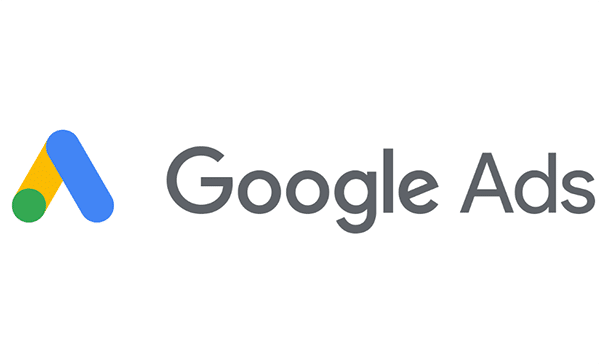
Google Consent Mode V2 introduces new challenges for advertisers using Google Ads. Understanding these challenges is key to optimizing your ad campaigns and respecting user privacy.
Ad Personalization
One of the biggest changes with Consent Mode V2 is how it handles user data for ad personalization. When users opt out of cookies, Google Ads can no longer use detailed personal data to tailor ads specifically to them. This limits the ability to deliver highly targeted ads based on user behavior. Marketers need to find new ways to engage users without relying heavily on personal data, which requires creativity and a deep understanding of audience preferences.
Tracking Conversions with Consent Limitations
Conversion tracking is vital for measuring the success of ad campaigns. However, if users do not consent to tracking, it becomes challenging to understand how ads are performing. Without this data, optimizing ad strategies becomes difficult. Marketers must develop new methods for tracking conversions and assessing performance while respecting user choices.
Remarketing Under Restriction
Remarketing is a powerful strategy to re-engage users who have previously visited your website. However, with limited user data due to consent restrictions, remarketing becomes more complicated. Advertisers need to approach remarketing carefully, ensuring they respect privacy while still reaching potential customers effectively.
Adapting to New Consent Practices
With Consent Mode V2, Google Ads must operate according to user consent choices. This means advertisers must adapt their targeting and measurement strategies based on what users allow. Being flexible and ready to adjust your approach is essential in this new landscape, where respecting privacy is as important as achieving marketing goals.
Consent Management is Required
To use Google Ads effectively, businesses must now implement Google Consent Mode V2 and obtain cookie consent from users. This requirement ensures that all data collection aligns with user preferences and legal standards, protecting both the business and its customers.
FAQ
How Is Consent Mode V2 Different from Consent Mode V1?
Consent Mode V2 is an updated version of Google’s tool for managing user consent on websites. It builds on the original Consent Mode V1 by providing more options and better ways to follow privacy laws. With Consent Mode V2, businesses have more control over what data they collect from users and how they use that data, making it a stronger tool for protecting personal information.
The biggest difference between Consent Mode V2 and V1 is the level of control and customization it offers. In Consent Mode V2, you can set more specific rules for how data is collected and used. This means you can decide exactly what types of data you want to collect and how you want to use it. This flexibility helps businesses follow privacy rules more easily and ensures that user data is handled with more care.
The new version also adds extra consent settings, which give businesses even more control over data. These settings make it easier to decide what data to collect and how to use it, based on what the user agrees to. With these detailed options, Consent Mode V2 is a more powerful tool for protecting user privacy.
What Happens If You Don’t Use Google Consent Mode?
If you are using the old version of consent mode (V1), it will still work. However, to use all the new features, you need to update to Consent Mode V2. This update helps Google correctly handle new data settings like ad_user_data and ad_personalization.
If you don’t activate Google Consent Mode, your website won’t send data to Google advertising platforms. This means you won’t be able to measure website traffic, create audience lists, or do remarketing effectively. As a result, your marketing campaigns might not perform as well and could become less effective.
Is Google Consent Mode V2 mandatory for all websites?
Yes. Starting in March 2024, Google Consent Mode V2 will be required for all websites using Google services like Google Analytics and Google Ads. If you don’t update to Consent Mode V2, your website won’t be able to collect data from new users in the European Economic Area (EEA) or the UK. This could make your marketing campaigns less effective because you’ll miss out on important data needed to optimize ads and track performance.
To continue using Google services properly, you need to set up Consent Mode V2 with a Google-certified Consent Management Platform (CMP). This ensures you follow privacy laws and keep getting valuable insights from your data.
Final Thoughts
Google Consent Mode v2 is more than just a compliance tool—it’s a powerful resource for businesses looking to navigate the complexities of digital privacy. By implementing this tool, you can protect user data, maintain compliance with evolving regulations, and continue to gather valuable insights for your marketing efforts. You have the deadline, now is the time to act!
